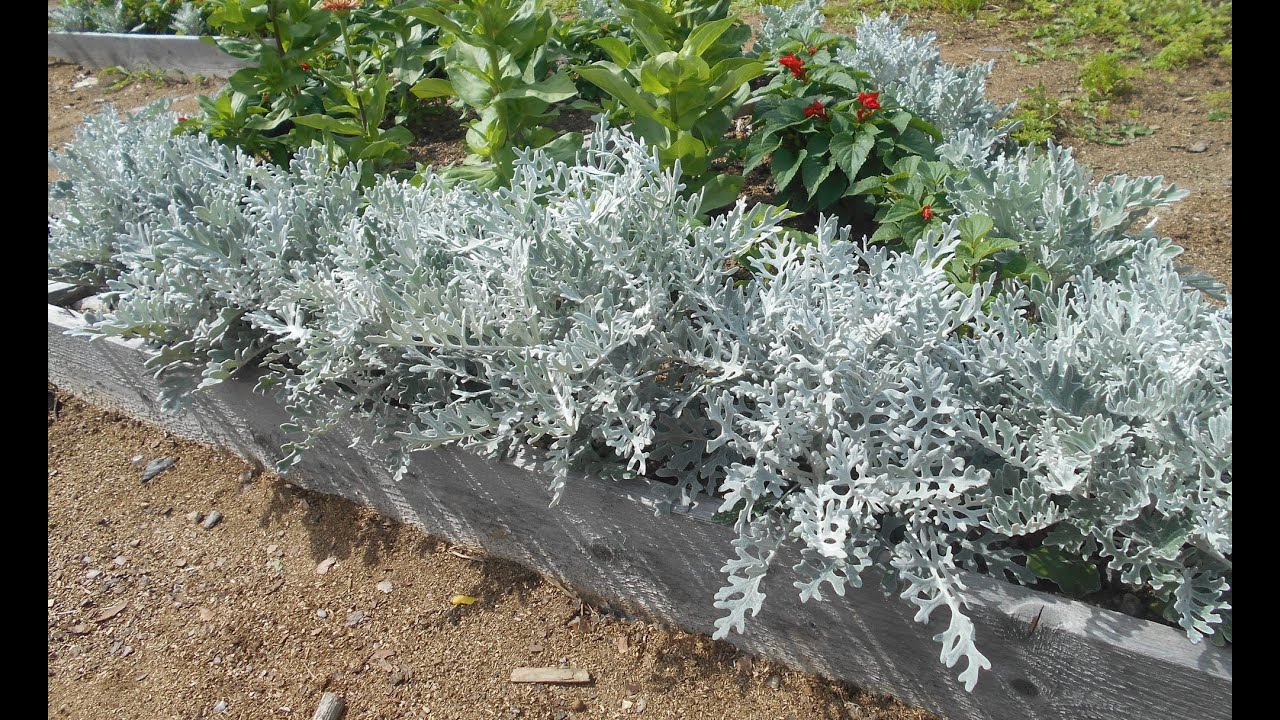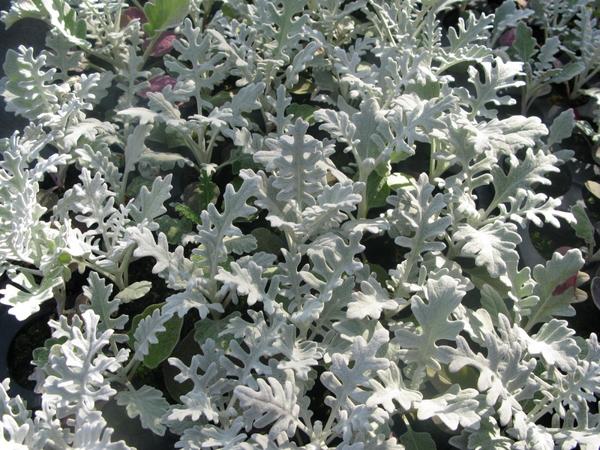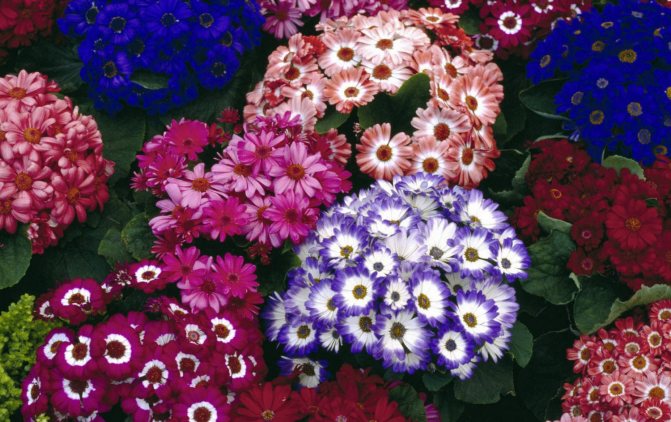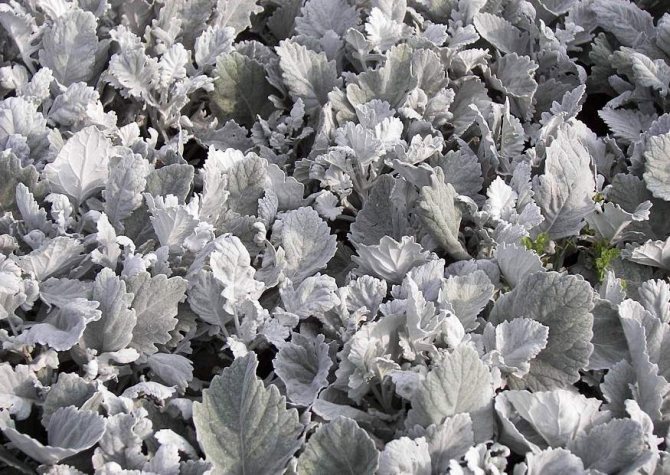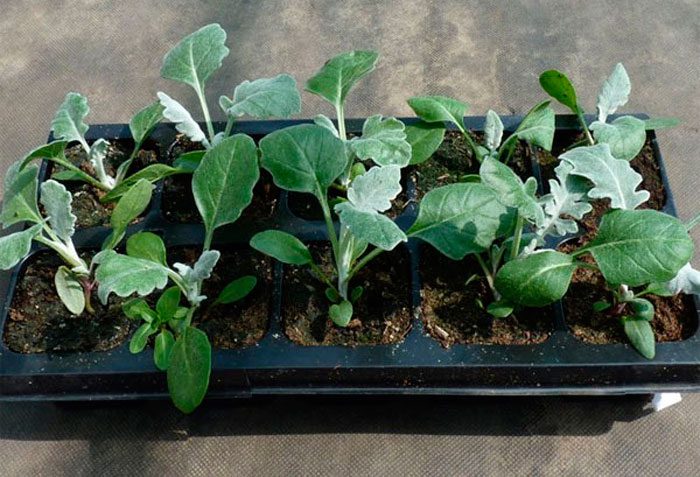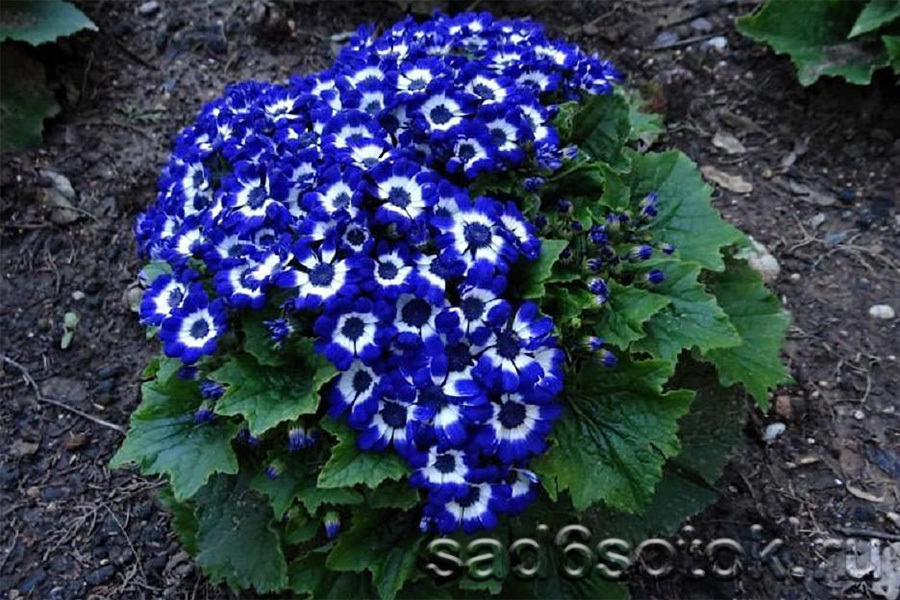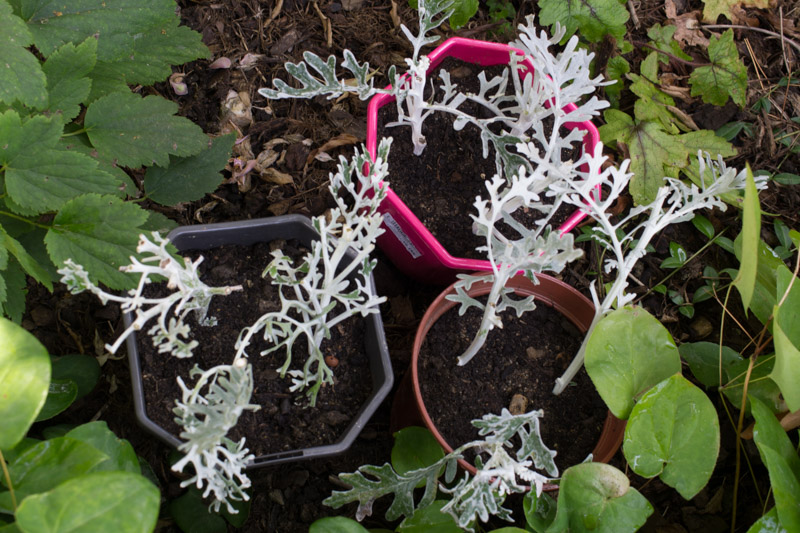How to properly plant seaside cineraria for seedlings
The correct planting of silvery cineraria for seedlings at home is not only sowing seeds, but also the choice of a suitable soil, capacity, preparation of seed. And each seeding step has its own tricks and nuances.
Seed preparation
Seeds of seaside cineraria can be sown on seedlings without preparation. However, if you soak in a growth stimulant solution (for example, in the preparation Zircon, Epin-Extra), then germination will improve and you will generally see more friendly shoots.
Soil preparation
Seedlings of silver cineraria will be most comfortable in loose, light, fertile soil. You can plant seeds in ordinary universal seedling soil. But if it turns out to be too dense, it is recommended to add a loosening element to it, for example, sand, vermiculite, perlite.
If you want to make your own potting mix, you can mix the following ingredients: turf (2 parts), peat (1 part), sand (1 part).
Choice of capacity
A wide and not very deep bowl, about 8-10 centimeters high, is ideal. This can be either a special box for seedlings, or a regular food container, or some other container.
You can sow cineraria seeds for seedlings in cups or cassettes. But it is still convenient to first put in a common box, and then dive.
The seedling container must have drainage holes to remove excess moisture. If they are not there, then you need to do it yourself, for example, with a nail, a soldering iron, scissors.
Sowing workshop
The following instruction with step-by-step photos will help to correctly plant the seeds of silvery cineraria on seedlings:
1) Fill the bottom of the container with a drain.
You can use expanded clay, perlite, broken brick. The optimal size of the drainage layer is 1.5-2 cm.
2) Fill the container with soil.
It is necessary to distribute the soil evenly so that voids and irregularities do not form. Leave a small distance to the edges of the container, about 2-3 centimeters.
3) Moisten the soil abundantly.
4) Sow.
As you can see in the photo, the seeds of the silvery cineraria are not very large:
Due to their small size and lightness, it is most convenient to sow with a wooden toothpick. Soak one end of a toothpick in water, the moisture will help the seed easily stick to it.
Bring the end to the seed and pick up one seed:
Plant it in the ground by lightly rubbing the end of the toothpick on the ground. Alternatively, you can bring the product to the ground and brush off the seed with another toothpick.
You can also sow with your fingers, as if adding:
5) Water after planting.
This must be done from a spray bottle. Thanks to him, moisture will spread most evenly and the seeds will not sink under the pressure of water.
6) Cover the container with a lid or plastic wrap to create a mini greenhouse.
7) Sign your seedlings to avoid confusion with other plants.
Popular varieties of seaside cineraria
Seed propagation (in the Moscow region only through seedlings) allows amateur flower growers to grow their favorite varieties. We usually buy seeds, although the quality of our seeds is much higher. Their germination rate is close to 100%, and purchased seeds in beautiful bags sometimes germinate poorly. Therefore, I buy several packages of seaside cineraria from different manufacturers at once.
I like the fast growing Silver Dust variety. This low compact plant 15 - 25 cm high is decorated with lace of carved silvery leaves with slight pubescence. It is this popular variety that is often planted by urban gardeners.Some seed companies sell the Silver Dust variety under the name Silver Dust.

Cineraria sea grade "Silver dust"
Cineraria "Silver" 15 - 25 cm high has deeply dissected silvery-white leaves.
The rather tall (45 cm high) variety "Cirrus" with serrated silvery-green oval leaves looks quite different. Young bushes may not immediately turn silver-white, they only acquire this paint over time.
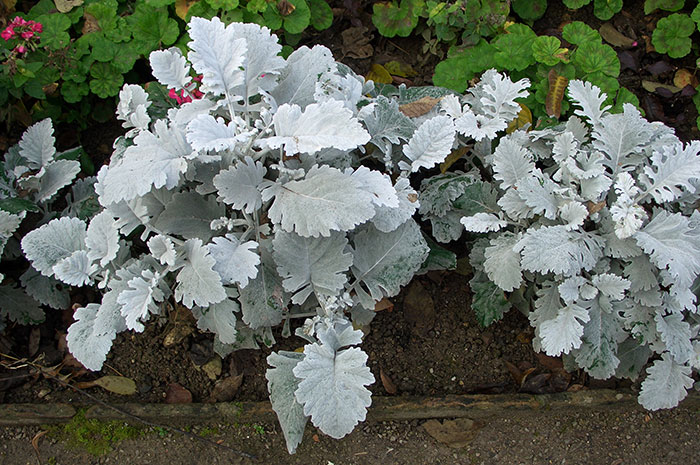
Cineraria seaside, grade "Cirras"
The undersized variety "Andromeda" (15 cm) has pinnately-divided leaves, covered with a silvery felt below. In August, inflorescences of small flowers appear, which are removed. This is one of the most perfect varieties!
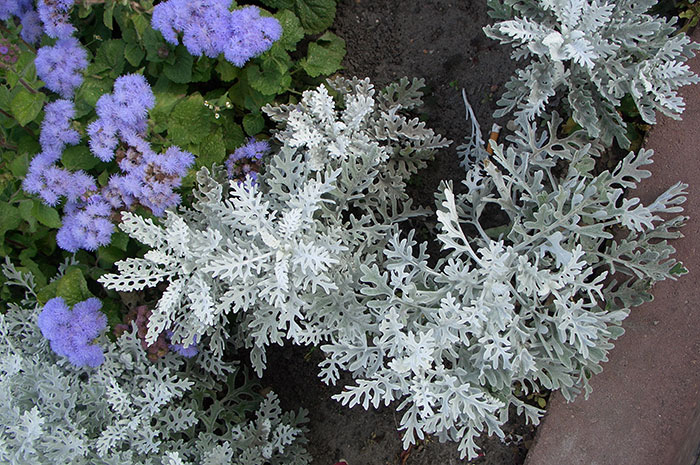
Cineraria sea, grade "Andromeda"
The Kandikans variety is distinguished by the rounded shape of gray-silvery foliage.
The undersized variety "Diamond Powder" is only 20 cm high and has a silvery ash carved foliage.
1. Seven Secrets of Success:
| 1. Growing temperature: throughout the year the temperature is from 18 to 29 ° C. |
| 2. Lighting: Well-lit location with plenty of reflected sunlight. |
| 3. Watering and air humidity: abundant and regular watering in spring and summer with light drying of the topsoil. In the fall, the frequency of watering is reduced in accordance with the temperature of the content. The air humidity can only be increased when the heat is intense in summer or when the central heating is on. |
| 4. Pruning: sanitary - carried out to maintain an attractive appearance and prevent the spread of fungal diseases, is the timely removal of old yellowed leaves and wilting flowers with a sharp sterile instrument. |
| 5. Soil: nutritious and loose organic-based substrate with excellent drainage and slightly acidic pH. |
| 6. Top dressing: in spring and summer, top dressing 2 times a month, in autumn and winter, fertilization is stopped and resumed only in spring. with the appearance of the first young leaves. |
| 7. Reproduction: cuttings in spring and summer or sowing seeds in spring. |
Botanical name: Cineraria.
Cineraria flower is a family.
Origin. The plant is native to the tropical regions of Africa.
What it looks like. Cineraria are attractive flowering herbaceous plants.
The leaves are simple, green, forming a basal rosette, spear-shaped or heart-shaped, with well-pronounced numerous veins. The surface of the leaf blade has sparse pubescence and finely toothed margins.

The flowering of cineraria is so abundant that the leaves are practically hidden under the flowers. Peduncles slightly exceed the height of the leaf rosette and bear small - with a diameter of 3 - 7 cm, but very bright flowers in shades of blue, pink, burgundy, white, purple and red.
Plants with 2-tone flowers are often found.

Certain types of cineraria do not have a lush flowering, but they differ in silvery-white foliage, which will perfectly set off any other plants.

Height. Depending on the variety, the plants grow to a height of 30 - 60 cm. The size of the plant will also depend on the conditions in which it is kept.
How to plant?
Considering this culture for rooting in your garden, it is worth knowing some of the nuances regarding the planting of cineraria. In general, all varieties of groundwort adapt well and develop in any soil. However, the plant will feel best in soils enriched with useful microelements with good aeration, without moisture stagnation, which can lead to decay of the root system.

Therefore, before planting, it is recommended to fertilize the selected area with mineral compounds intended for garden flowers. If you plan to plant several shrubs, then the holes for planting need to be prepared in increments of 20-25 centimeters, this also applies to the intervals between the rows.If there is a desire to get a thick continuous carpet of cineraria on the flower bed, then the distance between the seedlings can be reduced.


The planting algorithm includes several steps.
- On the site, the required number of holes is dug with a depth greater than the root system of the plants selected for planting.
- Rooting involves placing the cineraria in the middle of the pit, together with an earthen lump. At the same time, one should try to preserve its integrity.
- Further, the soil is compacted, the crops are irrigated.
- If planting is carried out during a period when night frosts are possible, you should take care of the shelter for flowers at night. For these purposes, you can use any non-woven material, garden film.

A suitable temperature for the development of cineraria in the open field is + 20 ° C. However, healthy plants that have already passed the adaptation period after planting are able to withstand minor daily differences in thermometer values. The critical temperature for the culture will be + 4 ° C and below. In such conditions, the aboveground part of the plant will begin to die off.


Planting and growing
Cineraria silvery will give almost no trouble if you want to try growing from seed. They can be purchased in almost any store, the seeds are distinguished by the ability to germinate well and quickly. The best time to sow cineraria seedlings is March, but it's not too late to do this in April, including May.
There are several ways to plant cineraria seeds - they all provide a decent result:
- You can sow cineraria in moist soil, while the seeds should not be planted, it is enough to crush them a little and cover with a film.
- Another way is to also plant the seeds in a container with moist soil, then sprinkle them with sand and cover them with glass or film.
- Finally, cineraria seeds sown on the outer soil layer can simply be covered with a layer of tissue paper, which, being moist, will allow the seedlings to break through it. Again, cover the container with insulating material.
In all three cases, covering with a film or glass is necessary, such an interlayer guarantees the maintenance of the proper level of humidity
By the way, watering the soil after planting must be done very carefully, a powerful jet can knock down small seeds and break the accuracy of planting. You can spray the ground with a spray bottle, or you can choose a container with drainage holes from the very beginning and immerse it in a stand with water so that the soil gets wet from below
Sowing seedlings
Cineraria seeds are sown for seedlings around the beginning of April. Although they are quite small in size, the entrances appear very quickly and amicably. Sowing cineraria is allowed both in one common box with further picking, and immediately in separate cups or pots.
For germination of seeds, choose a light, neutral water and air permeable soil. Before sowing, it is moistened and compacted, then the seeds are coated on top, without burying them in the soil. Then the box is covered with foil or glass to create a greenhouse effect. Also, the seeds can be sprinkled with a thin layer of sand or covered with damp tissue paper, and then covered with a film. In any case, they sprout perfectly.
Watering containers with seeds must be very careful - a strong jet of water can wash the seeds or break the thin stems of plants. It is safer to use a spray gun or containers with drainage holes for these purposes.
In the second option, they can simply be immersed in a pan with water for a while so that the soil gets wet.
At a constant air temperature not lower than +20 degrees, seedlings are shown after 10-14 days. After that, the box with the seedlings is rearranged closer to the light source - a window or phytolamps, and the film is removed.It is advisable to do this gradually, increasing the airing time, so that the seedlings have time to harden and get used to the environment.
After the seedlings have 2–4 true leaves, they are dived into separate containers (if the seedlings were sown in a common box). To do this, pry a lump of earth with roots and move it to a separate pot.
It is important to compact well and water the sprout at the end of the transplant so that the soil settles down and air comes out from under the roots
In this case, you need to work very carefully so as not to damage the small roots.
Cineraria withstands transplants well, therefore, after a pick, it grows very quickly and becomes stronger. As soon as the threat of night frosts has passed, the seedlings can be planted in open ground in a permanent place - most often, this happens in late May or early June.
When planting cineraria on a flower bed, it is necessary to observe the optimal distance - 20 centimeters between plants and at least 25 centimeters between rows. If it is needed to form a living carpet, then you can plant it more tightly.
Sowing in the ground
Cineraria silvery also grows remarkably with direct sowing of its seeds in open ground. It is recommended to do this at the end of May, when the frost has passed. At the same time, it is necessary to be prepared for the fact that the germination and flowering time is slightly shifted compared to growing through seedlings - by about 1-1.5 months.
You can sow seeds both on specialized seed beds, from where the seedlings are planted in a permanent place, observing the prescribed interval, and immediately on the flower bed. In the second case, after the emergence of seedlings, it will be necessary to thin out the planting several times in order to provide the growing cineraria with enough space to live.
No matter how cineraria is grown, it is advisable to insulate new plants in open ground with a covering material for the first time in order to protect them from possible night frosts. The rest of the planting care is simple - regular watering and weeding from weeds.
Planting malopa in open ground
Growing from seed to seedlings
It has already been mentioned above that malopa grown in a garden plot is an annual. That is why it has to be grown from seed every year.
This crop is grown through seedlings, while the time of sowing seeds depends entirely on the climatic conditions of your region. You can sow the seeds of malopa throughout the spring, the main thing should be taken into account that when the time comes for transplanting seedlings into open ground, the air outside should already be well warmed up. And it should also be borne in mind that even a slight frost can harm flowers.
Therefore, it is so important that return spring frosts are left behind.
Before proceeding with the direct sowing of seeds, you need to prepare special seedling boxes. They are filled with loose peat soil. Malopa seeds are small and can break easily if you press hard on them. Therefore, after they are evenly distributed over the surface of the substrate, they only need to be pressed a little into the soil. It is not necessary to sprinkle them on top with either substrate or sand.
After the seeds are sown, you need to moisten the crops. It is recommended to water them with a sprayer. This will protect the seeds from washing out, and you can also avoid stagnation of moisture in the soil mixture, which can negatively affect young immature seedlings.
Next, it is very important to cover the top of the box with transparent glass or film. This will help prevent the surface of the substrate from drying out and maintain the required moisture level.
Do not forget to systematically ventilate and moisten the crops, and immediately after the first shoots appear, be sure to remove the shelter. Young seedlings are rearranged in a well-lit place, protected from direct sunlight. They are also provided with regular, moderate watering.It is recommended to transplant seedlings into separate cups after the appearance of the first true leaf plates.
Landing in the garden
When planting grown seedlings of a hole in open ground, you need to be extremely careful not to injure both the stems and the root system of the plant.
The first step is to prepare the site for planting. The soil is dug in advance, while a little organic matter is introduced into it. Prepare the planting holes immediately before planting the plants. Their depth can vary from 50 to 100 mm. The row spacing, as well as the distance between the bushes, should be at least 30–35 centimeters. Plant malopa in prepared holes and water well.
Cultivation of malopa and lavater on a personal plot without seedlings, watering and feeding.
Types and varieties of cineraria
Cineraria graceful, or graceful groundwort (Senecio elegans = Cineraria elegans) is a perennial or biennial plant native to southern Africa, which is grown in culture as an annual. In height, the highly branched stem of this species reaches from 30 to 60 cm. The leaves forming the basal rosette are large in size, the stem leaves are much smaller. Both stems and leaves are covered with sticky pile. Baskets, opening from mid-June to autumn, are collected in corymbose umbrellas. The reed flowers can be white, pink, crimson, purple or red, and the middle ones are always yellow. The graceful cineraria has two popular varieties:
- Nanus - dwarf bushes up to 25 cm high;
- Ligulosus is a plant with double baskets of white, red, purple or purple reed flowers.
Bloody cineraria, or hybrid cineraria (Senecio cruentus = Pericallis cruenta = Senecio hybridus = Cineraria cruenta) comes from the Canary Islands. Her leaves are light green, oval, slightly pubescent. Baskets with reed flowers of various colors and a yellow center of tubular flowers resemble daisies - sometimes double, sometimes two-colored. This species is used both for growing in the garden and as a pot plant. The best varieties:
- The masterpiece is a low bush with simple chamomile-like baskets with a yellow center and wide pale pink reed flowers;
- Grandiflora - a line of varieties reaching a height of 45 cm, with large baskets with a yellow center and ligulate flowers of various colors;
- Double - bushes up to 70 cm high with baskets up to 5 cm in diameter;
- Stellata - a form up to 70 cm high with small star-shaped baskets;
- Nana - compact low bushes with baskets of bright colors.
Seaside cineraria, or silver cineraria, or silvery cineraria, or seaside cineraria (Cineraria maritima = Senecio maritima) is found in the nature of the Mediterranean. In culture, this decorative deciduous perennial plant is grown as an annual. It has pinnately-divided leaves covered with thick silvery pubescence underneath, which makes the plant look like a tomentose. Unattractive inflorescences from yellow flowers are best removed as they appear. The best varieties of the species:
- Cirrus - bushes up to 45 cm high with oval silvery-green leaves with jagged edges. Over time, the color of the leaves becomes silvery white;
- Silver boat is a white-silvery plant with erect stems and finely dissected leaves covered with tomentose pubescence;
- Dast and Silver are undersized compact varieties with silvery leaves.
How to care?
In order for the culture to demonstrate the maximum attractiveness, as well as to develop correctly, it will be necessary to perform a number of obligatory agrotechnical measures.

Watering
Cineraria is resistant to drought, therefore, in the middle lane, natural precipitation is usually quite enough for it to feed. However, a prolonged lack of watering should still be avoided in any case.It is possible to determine that the plant in the flower bed does not have enough moisture by the appearance of the aboveground part - the leaves of the wild rose become lethargic, and flowering also stops or does not occur at all.

It is most correct to carry out root watering, avoiding moisture on the green mass. For irrigation, it is recommended to take only warm water, previously settled. The liquid should be injected into the aisles, then loosened, remove weeds.


Top dressing
For good flowering and growth, cineraria bushes are best fed additionally. Some gardeners use mineral complexes twice a month. However, for the full development of the plant, one introduction of nitrogen-containing compounds in the phase of active growth will be enough until the buds are laid in the spring.

Pruning
In order to grow a beautiful flowering plant in the garden, in the process of caring for cineraria, it is necessary to timely correct the pruning of wilted buds in a timely manner. Such simple manipulations will stimulate the plant to form new ovaries.

Wintering
In regions with a mild climate, the wild rose bushes can be left in the flowerbed for the winter in order to preserve the culture in the garden for the next year. To exclude unwanted freezing, gardeners usually resort to covering the plant with a layer of mulch, using garden foliage for this. In the spring, the shelter will need to be removed, sanitary pruning of the fragments that suffered in the winter period should be carried out.



Cineraria - growing and care
Like other plants, cineraria needs proper care, for which follow these recommendations:
Fertilizers need to be applied every 15 days and it is better to use complex additives. When buds appear, fertilize once a week, alternating mineral and organic fertilizers.
To prolong the flowering period, flowers should be cut as soon as they begin to wilt. If you need to preserve the decorativeness of the foliage, then the buds should be cut.
Growing cineraria from seeds involves irrigation with settled water at room temperature
It should be poured exclusively at the root, since water getting on the leaves and flowers is dangerous.
It is important to consider that moisture is important for this flower, and it is better to keep it at a temperature of 15 ° C. Spray several times a day
Doesn't like cineraria drafts.
For planting a flower, choose a nutritious and loose soil, for example, you can mix peat and compost in equal amounts. In addition, it is recommended to add a little bark to the mixture, which will ensure the air permeability of the earth.
To preserve cineraria for the next year, planting and care in the open field means covering the bushes with dry foliage. For the winter, you can transplant the plants into pots by placing them in a bright place with a cool temperature.
Cineraria - planting seedlings
Can be used for planting cuttings and seeds. The second option is the most common. The best timing for planting cineraria is from March to May. The procedure is carried out as follows:
- Water a suitable soil, spread the seeds on top and press them a little. Sprinkle with sand on top and cover with glass or foil.
- Watering should be done carefully and it is recommended to use a spray bottle for this.
- Shoots will appear in a week and a half. After that, remove the film and place the containers on a light windowsill.
Cineraria - seedling care
There are several rules regarding the proper care of seedlings so that they develop quickly and get ready for transplanting. Caring for cineraria after germination includes:
Lighting. Place containers with crops on the windowsill, where there will be a lot of light, but it should be diffused, since the direct rays of the sun are dangerous.
Watering
At the very beginning of growth, proper watering is important, but it is important not to overdo it with water, so as not to provoke the occurrence of root rot. Drought is dangerous for seedlings.
Leaving before landing in open ground includes a dive
Transplanting into separate pots is carried out when two full-fledged leaves appear on the sprouts.
Cineraria - when to plant in open ground?
Planting seedlings should be carried out after warm weather is established and you can not be afraid of frost at night. The most suitable time is mid-May. Planting cineraria in open ground should be carried out in a sunny area, but shading will be useful at lunchtime. The soil must be drained, nutritious and neutral. In order for cineraria to begin, planting and care in the open field should be carried out according to the following scheme:
- There should be 20-25 cm between the seedlings. Plant with a clod of earth.
- At the end, tamp the soil and water. If you are afraid of a drop in temperature, then cover the bushes with lutrasil at night.
Diseases of cineraria
If planting in open ground was carried out incorrectly and care is performed with errors, then reddish-brown spots will appear on the flower and they appear due to extreme heat and drought. If the tip is not affected, then it can be separated and rooted. It is worth finding out why the cineraria wilted in the open field, and so if the leaves became stunted, then this in most cases indicates moldy roots. To solve the problem, it is better to carry out a transplant.
Types of cineraria
All ground plants have a rather long growing season - up to 9 months.
Conventionally, all types of this plant (and there are about 50 of them in nature) can be divided into decorative deciduous and flowering rose flowers, which are mainly grown in pots. These include: blood red, graceful and hybrid cineraria.
But still, deciduous forms are valued more for the unusual silvery color and openwork shape of the leaves. To decorate the plots, the seaside cineraria (Cineraria maritime) is most often planted. It is considered an excellent background plant, suitable for decorating alpine slides, gravel gardens, rabatoks, mixborders, suitable for curbs, found in city squares. The leaves of many varieties are pubescent or have a whitish felt bloom, for which they are called silvery, and grow very intensively. Flowers for gardeners do not provide value, flower stalks are usually broken out immediately after emergence.

So cineraria blooms
In the Caucasus (Black Sea coast) and in the southern part of Crimea, cineraria grows without any shelter, like a perennial wild plant, scattering seeds throughout the area, populating rock crevices and stony soils.
Caring for cineraria in the garden
How to care for cineraria
Planting cineraria and caring for this African beauty in the open field is not at all difficult: the cultivation of cineraria involves regular watering, loosening the soil between the bushes, weeding and feeding. And do not forget to remove wilted inflorescences in order to increase the flowering time of cineraria, and in decorative leafy species, the buds should be cut as soon as they appear. As you can see, everything is very simple. However, it should be remembered that poor or insufficient care can cause illness and death of cineraria, so try to perform the necessary care procedures correctly and in a timely manner, especially since it is not at all difficult.
Watering and feeding cineraria
From a lack of moisture, cineraria weakens, withers and dies, and from excessive moisture, the roots of the plant can rot. Since cineraria is drought-resistant, it will need watering only on very hot and dry days in a season with normal rainfall. Water heated in the sun is used to moisten the soil. After watering or rain, do not forget to loosen the soil around the bushes so that air can flow to the roots of the plant. At the same time, weeds can be removed from the site.
Cineraria are fed with both organic fertilizers and mineral complexes in the form of solutions, which are introduced into the pre-moistened soil 2-3 times a month alternately. Organic fertilizing means solutions of chicken manure (1:15) or mullein (1:10).
Cineraria after flowering
Since thermophilic plants in our climate are grown in an annual culture, at the end of the season, when the beautifully blooming cineraria loses its attractiveness, it is destroyed: the bushes are pulled out, plant residues are carefully collected, and the soil on the site is dug to the depth of a shovel bayonet. If you live in an area where frosty winters are the exception rather than the rule, you can try to preserve decorative deciduous cineraria until next season by covering the bushes with a thick layer of dry leaves. In the spring, remove the shelter and cut off the frozen bushes so that they do not interfere with the young growth. Or you can transplant the garden cineraria into a pot in the fall and keep it in a cool, bright room in winter, not allowing the soil to dry out, and return the plant to the flower garden in the spring.
Prevention measures
If you have diabetes, hypertension, ischemic heart disease, thyroid problems, do not start the disease. Visit your doctor on time, follow his instructions. Ignoring medical recommendations, undisciplined pill intake significantly increase the chances of developing AMI.
It is also necessary to regularly undergo medical examinations, take tests. Determination of the level of cholesterol, sugar, measurement of blood pressure, ECG monitoring help to identify diseases at the earliest stages and take timely measures to prevent progression.
To avoid recurrence of myocardial infarction, you need to adhere to a few simple rules:
- stressful situations must be avoided;
- you should eat extremely healthy foods, exclude fatty, fried, pickled, spicy and salty foods from the diet;
- good rest, normal sleep is an excellent prevention of heart attack;
- does not hurt to go in for sports, do gymnastics or make up an easy set of exercises;
- it is necessary to give up addictions: smoking, drinking alcohol.
In order not to undergo such a disease as myocardial infarction, it is necessary to prevent the occurrence of vascular atherosclerosis. For this, preventive measures are taken:
- Introduction to the diet of fiber of vegetables and fruits, reducing the proportion of fatty, fried, smoked food.
- Leading an active lifestyle;
- Fight against bad habits, smoking, alcohol consumption;
- Prevention of stress by mastering the methods of relaxation, auto-training;
- Control of cholesterol and blood sugar levels, timely treatment of chronic diseases;
- Consultation with a specialist when symptoms of angina pectoris appear, ECG.
Myocardial infarction is a dangerous disease with a high proportion of deaths and severe complications. Its cause is spasm and blockage of the coronary arteries. Myocardial infarction is manifested by various symptoms, the main of which is acute chest pain.
This cardiopathology requires immediate medical attention, hospital treatment. In order for rehabilitation after a heart attack to be successful, you need to take the drugs recommended by the doctor, follow a diet, and engage in physiotherapy exercises.
Growing cineraria from seeds
Seaside cineraria is usually propagated by seeds from the end of January to the second decade of March. Earlier dates allow you to get seedlings for decorating verandas, glazed loggias and balconies. February crops are suitable for growing seedlings for flower beds and outdoor pots, various vertical structures and living figures.
It is advisable to pre-treat purchased seeds with Epin, aloe juice or other stimulants in order to increase their germination.The best germination result is with surface crops. Dusting the planting site with soil can reduce the number of seedlings. I arm myself with two toothpicks and spread the small enough seeds over the surface of the soil. They need to be slightly pressed into the moistened soil mixture, and then cover the container with glass, a transparent lid, or place it in a plastic bag. At a temperature of about 22 - 24 ° C, seedlings appear in 7 - 10 days, in a cooler room - a few days later.
The seedlings develop slowly at first. The pick is carried out at the stage of a pair of true leaves. By this time, a good root lobe is growing, which cannot be injured when diving. After another month, I transplant the grown seedlings into small individual pots or other containers. Seedlings left in the planting tank without picking noticeably lag behind in development.
From mid-May to early June, the seedlings of the groundwort are planted in a flower garden. The distance between the bushes of low-growing varieties should be at least 20 cm, higher ones - about 25 cm. During the spring night frosts, the planted seedlings are covered with lutrasil or other non-woven material for safety reasons.
Soon, young bushes grow, become beautiful and strong. Sometimes they bloom at the end of summer, which allows you to collect seeds from them. I cut off most of the inflorescences.
Varietal variety of Cineraria
Among the varietal diversity, there are several that are most popular:
- Cineraria seaside "Silver dust". Perennial. Visually it looks like a low-growing bush, the maximum height of which can reach 40 cm. It has powerful, well-branched shoots that form a fur crown. The foliage is silvery-white and slightly pubescent.
- Silver Falls. An annual representative of the species, distinguished by its miniature size. The height of the bush reaches 25 cm. Branches are broadly branched, foliage is openwork, silvery-white.
- Cirrus. Young shoots have a greenish-whitish hue, which changes to metallic with age. The bush reaches 45 in height, has a well-developed crown.





